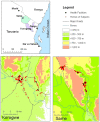Cost implications of improving malaria diagnosis: findings from north-eastern Tanzania
- PMID: 20090933
- PMCID: PMC2806838
- DOI: 10.1371/journal.pone.0008707
Cost implications of improving malaria diagnosis: findings from north-eastern Tanzania
Erratum in
- PLoS One. 2010;5(1). doi: 10.1371/annotation/84df39c4-a548-4214-af76-09068fdc2c4c
Abstract
Background: Over diagnosis of malaria contributes to improper treatment, wastage of drugs and resistance to the few available drugs. This paper attempts to estimate the rates of over diagnosis of malaria among children attending dispensaries in rural Tanzania and examines the potential cost implications of improving the quality of diagnosis.
Methodology/principal findings: The magnitude of over diagnosis of malaria was estimated by comparing the proportion of outpatient attendees of all ages clinically diagnosed as malaria to the proportion of attendees having a positive malaria rapid diagnostic test over a two month period. Pattern of causes of illness observed in a <2 year old cohort of children over one year was compared to the pattern of causes of illness in <5 year old children recorded in the routine health care system during the same period. Drug and diagnostic costs were modelled using local and international prices. Over diagnosis of malaria by the routine outpatient care system compared to RDT confirmed cases of malaria was highest among <5 year old children in the low transmission site (RR 17.9, 95% CI 5.8-55.3) followed by the >or=5 year age group in the lower transmission site (RR 14.0 95%CI 8.2-24.2). In the low transmission site the proportion of morbidity attributable to malaria was substantially lower in <2 year old cohort compared to children seen at routine care system. (0.08% vs 28.2%; p<0.001). A higher proportion of children were diagnosed with ARI in the <2 year old cohort compared to children seen at the routine care system ( 42% vs 26%; p<0.001). Using a RDT reduced overall drug and diagnostic costs by 10% in the high transmission site and by 15% in the low transmission site compared to total diagnostic and drug costs of treatment based on clinical judgment in routine health care system.
Implications: The introduction of RDTs is likely to lead to financial savings. However, improving diagnosis to one disease may lead to over diagnosis of another illness. Quality improvement is complex but introducing RDTs for the diagnosis of malaria is a good start.
Conflict of interest statement
Figures
Similar articles
-
Acceptability of malaria rapid diagnostic tests administered by village health workers in Pangani District, North eastern Tanzania.Malar J. 2016 Aug 27;15(1):439. doi: 10.1186/s12936-016-1495-z. Malar J. 2016. PMID: 27567531 Free PMC article.
-
Over-diagnosis of malaria by microscopy in the Kilombero Valley, Southern Tanzania: an evaluation of the utility and cost-effectiveness of rapid diagnostic tests.Malar J. 2013 May 10;12:159. doi: 10.1186/1475-2875-12-159. Malar J. 2013. PMID: 23663437 Free PMC article.
-
Increased use of malaria rapid diagnostic tests improves targeting of anti-malarial treatment in rural Tanzania: implications for nationwide rollout of malaria rapid diagnostic tests.Malar J. 2012 Jul 2;11:221. doi: 10.1186/1475-2875-11-221. Malar J. 2012. PMID: 22747655 Free PMC article.
-
Clinical performance of an automated reader in interpreting malaria rapid diagnostic tests in Tanzania.Malar J. 2013 Apr 24;12:141. doi: 10.1186/1475-2875-12-141. Malar J. 2013. PMID: 23617722 Free PMC article.
-
Accuracy of malaria rapid diagnostic tests in community studies and their impact on treatment of malaria in an area with declining malaria burden in north-eastern Tanzania.Malar J. 2011 Jun 26;10:176. doi: 10.1186/1475-2875-10-176. Malar J. 2011. PMID: 21703016 Free PMC article.
Cited by
-
Acceptability of malaria rapid diagnostic tests administered by village health workers in Pangani District, North eastern Tanzania.Malar J. 2016 Aug 27;15(1):439. doi: 10.1186/s12936-016-1495-z. Malar J. 2016. PMID: 27567531 Free PMC article.
-
Reduction of anti-malarial consumption after rapid diagnostic tests implementation in Dar es Salaam: a before-after and cluster randomized controlled study.Malar J. 2011 Apr 29;10:107. doi: 10.1186/1475-2875-10-107. Malar J. 2011. PMID: 21529365 Free PMC article. Clinical Trial.
-
Cost-effectiveness of malaria microscopy and rapid diagnostic tests versus presumptive diagnosis: implications for malaria control in Uganda.Malar J. 2011 Dec 19;10:372. doi: 10.1186/1475-2875-10-372. Malar J. 2011. PMID: 22182735 Free PMC article.
-
Should malaria treatment be guided by a point of care rapid test? A threshold approach to malaria management in rural Burkina Faso.PLoS One. 2013;8(3):e58019. doi: 10.1371/journal.pone.0058019. Epub 2013 Mar 5. PLoS One. 2013. PMID: 23472129 Free PMC article.
-
An innovative pay-for-performance (P4P) strategy for improving malaria management in rural Kenya: protocol for a cluster randomized controlled trial.Implement Sci. 2013 May 8;8:48. doi: 10.1186/1748-5908-8-48. Implement Sci. 2013. PMID: 23656836 Free PMC article. Clinical Trial.
References
-
- Chandramohan D, Jaffar S, Greenwood B. Use of clinical algorithms for diagnosing malaria. Trop Med Int Health. 2002;7:45–52. - PubMed
-
- Schellenberg D, Menendez C, Aponte J, Guinovart C, Mshinda H, et al. The changing epidemiology of malaria in Ifakara Town, southern Tanzania. Trop Med Int Health. 2004;9:68–76. - PubMed



